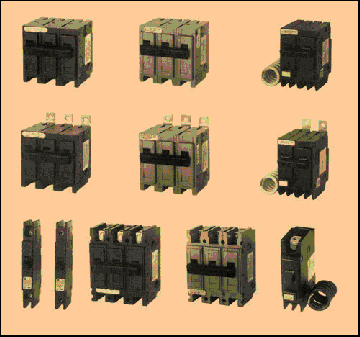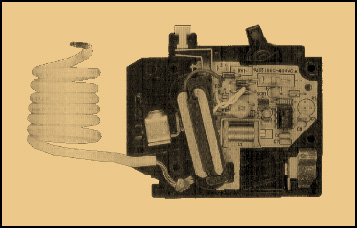 Miniature
Circuit Breakers
Miniature
Circuit Breakers
As
previously stated, a miniature circuit breaker is a device that switches and/or
protects the lowest common distributed voltage in an electrical system. It is
designed to protect conductors and insulation from damage due to Overload
(or Overcurrent) and Short
Circuit.
Think
about the electrical utility and where the electricity is generated. The
residential loadcenter is certainly at the end of the distribution system. It is
here that the voltages are the lowest of the distributed voltages in the
electric utility's system.
Miniature
circuit breakers are not just for residential applications only. They are used
in residential, commercial and industrial applications.
In
an industrial or commercial application, miniature circuit breakers can be found
in loadcenters, lighting Panelboards
and individual mountings.
Figure
1. Typical Miniature Molded Case Circuit Breakers

 Applications
Applications
Miniature
circuit breakers fall into two categories. These are:
- Residential-Residential
miniature breakers are only of the Plug-In
type. These are designed for residential loadcenters, commercial units, and
light industrial applications. They typically range from 10 to 125 amps,
with an interrupting rating of 10 or 22 KAIC.
- Industrial-These
breakers are designed for three types of mounting applications: plug-in, Bolt-On,
and Cable-In/Cable-Out.
(We will look at mounting methods shortly.)
Industrial
miniature breakers are designed to protect small branch circuits in commercial
or industrial electrical distribution systems. They are applied in loadcenters,
lighting panelboards or individual mounting applications. They typically range
from 6 to 125 amps, with an interrupting ratings as high as 65 KAIC.
Some
potential customers are original equipment manufacturers (OEMs) involved in
industrial control panels and electrical machinery, such as machine tool
equipment, material handling and packaging systems. In addition, look for
involvement with printing machines, food-processing systems, uninterruptable
power supplies (UPS) and HVAC (heating, ventilation and air conditioning).
Each
miniature breaker is rated to handle a specific load. For example, a circuit
breaker protecting a branch used with kitchen appliances has a higher rating
than a circuit breaker protecting a branch with an overhead lighting fixture on
it.
 Components
Components
Miniature
circuit breaker construction is simple, yet very precise. In fact, a miniature
circuit breaker has no replacement parts. It is not designed to be maintained.
When a unit goes bad, it is simply replaced.
 A
typical miniature circuit breaker has three main components. These are:
A
typical miniature circuit breaker has three main components. These are:
1-
Frame
The
Frame
has a molded case exterior. Its primary function is to provide a rigid,
mechanically strong, insulated housing in which the other components are
mounted.
2-Operating
Mechanism
The
Operating
Mechanism provides the means of opening
and closing the circuit. It has a three-position switch ("on,"
"off," and "tripped"). It can only be in the
"tripped" position as a result of an overcurrent. When power is
removed manually, it can only be switched to the "off" position. This
makes it is easy for a maintenance person to determine why power has been cut.
3-Trip
Unit
The
Trip
Unit is the brain of the miniature
circuit breaker. It activates the operating mechanism in the event of a
prolonged overload or short circuit. This type of circuit breaker uses a Thermal
Magnetic mechanism. This is the
predominant trip unit technology used in the domestic market. A bimetal and an
electromagnet work together to provide overload and short-circuit protection.
(The principles of how this works can be found in Module 5, Fundamentals of
Circuit Breakers.)
 Categorizing
Miniature Circuit Breakers
Categorizing
Miniature Circuit Breakers
Specifications
for miniature circuit breakers vary widely. As such, there is a miniature
circuit breaker to fit virtually any application, standard, and local code
requirement. In general, miniature circuit breakers are often categorized by the
following:
 Ratings
Ratings
Every
circuit breaker has specific ampere, voltage, and interrupting ratings.
The
Ampere
Rating is the breaker's continuous
current-carrying capability. In most cases, the ampere
rating should not exceed the current-carrying capacity of the circuit.
For example, if a conductor is rated at 10 amps, select a circuit breaker no
larger than 10 amps. Ampere ratings for miniature circuit breakers range from 10
to 150 amps.
There
are some specific circumstances when the ampere rating is permitted to be
greater than the current-carrying capacity of the circuit. For example, motor
and welder circuits can exceed conductor ampacity. This allows for inrush
currents and duty cycles. Limits are established by the NEC
(National Electrical Code).
The
Voltage
Rating of a circuit breaker must
be at least equal to the circuit voltage. It can be higher than the
circuit voltage, but never lower. For example, a 480-volt breaker can be used in
a 240-volt circuit. However, a 240-volt breaker could not be used in a 480-volt
circuit. Voltage ratings for miniature circuit breakers are 120/240-volt and
240-volt.
A
circuit breaker is also rated according to the level of fault current it can
interrupt. This is referred to as Ampere
Interrupting Capacity (AIC) (also called
"interrupting rating"). In an application, a
breaker must be able to interrupt the circuit's maximum short circuit current
(without damaging itself). Interrupting ratings for miniature circuit
breakers are 10, 22, 42, and 65 KAIC (thousand amps interrupting capacity).
 Poles
Poles
Miniature
circuit breakers are typically available in Single
Pole, Double
Pole, and three pole types. A
pole is a hot conductor. It is a space in a loadcenter, panelboard, or similar
device where a breaker can be attached. A single pole breaker disconnects
one conductor, and a double pole breaker disconnects two conductors. A three
pole breaker is typically used in industrial applications.
Single
pole breakers are associated with 120 volts, while double pole breakers are
associated with 240 volts. (For more detail on this subject, refer to Module 10,
Loadcenters.)
Miniature
circuit breaker poles are generally one inch in width. However,
some residential type breaker designs allow two poles to fit in the standard
one-inch space. This breaker type is called a Duplex
Circuit Breaker (or "half-size
branch circuit breaker"). Twice as many protective devices fit in the same
amount of available space, with the same ampere rating and without sacrificing
protection or features (Figure 6). However, these narrow
design configurations have current, voltage, and interrupting capacity
limitations.
Figure
5. 1/2 Inch per Pole and 1 Inch per Pole Circuit Breakers,
Same Ampere Rating (1/2 Inch on Left)

 Special
Application Breakers and Accessories
Special
Application Breakers and Accessories
In
addition to the general use miniature circuit breaker, there are a number of
breaker types that have been designed for a particular application. These
include:
- Ground Fault
Circuit Interrupter (GFCI)-This
breaker has a solid state trip unit. It detects ground currents (which are
small short circuits from one phase to ground), and trips to protect both
people and equipment.
Figure
9. GFCI Breaker
